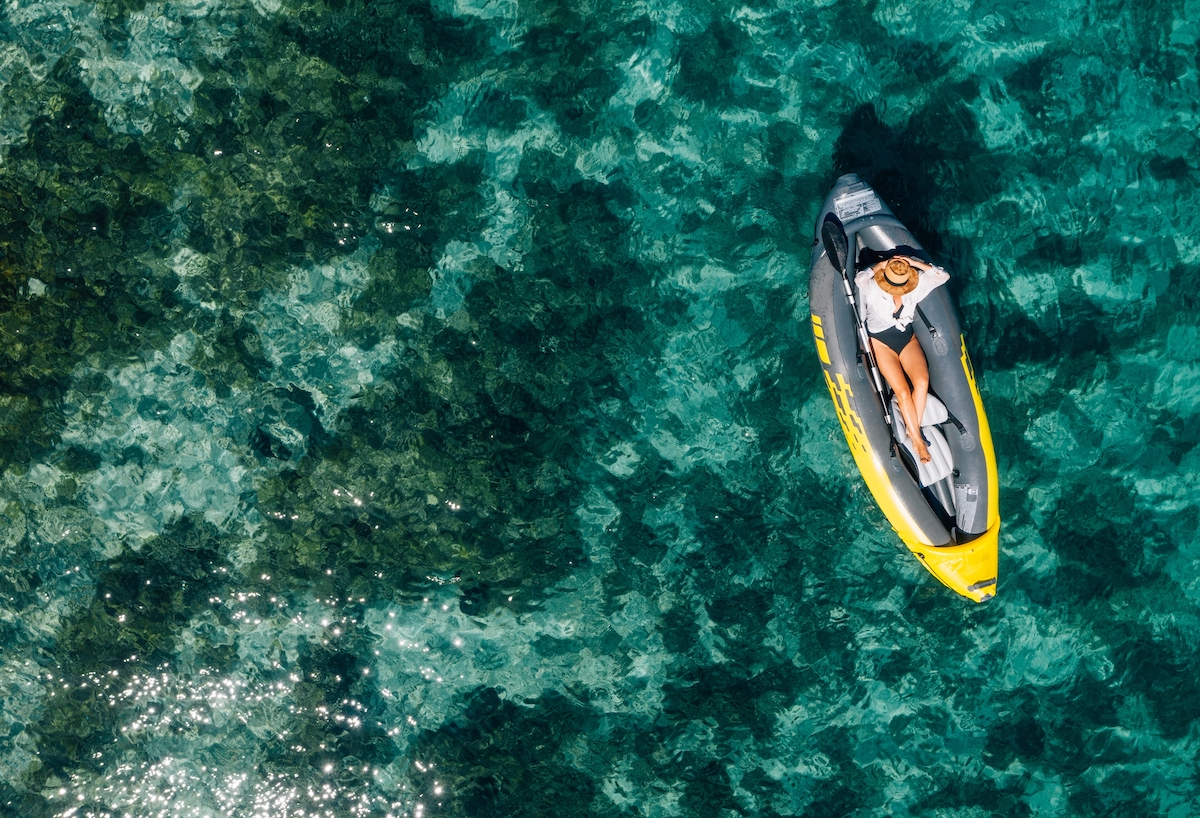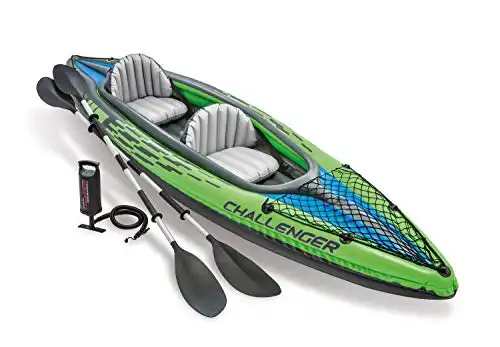Rigid Kayaks vs Inflatable Kayaks: Pros and Cons
Whether you’re a seasoned paddler or a newbie just dipping your paddle into the world of kayaking, one of the first choices you’ll face is whether to go with an inflatable or a rigid kayak.
It’s a decision that depends on several factors like portability, durability, performance, and cost.
In this guide, we’ll dive deep into the pros and cons of inflatable and rigid kayaks, giving you all the info you need to make an informed choice for your kayaking adventures.
Pros of Inflatable Kayaks

Inflatable kayaks come with a host of advantages that make them an attractive choice for many paddlers. First and foremost, their portability is unmatched. You can deflate an inflatable kayak, roll it up, and store it in a compact bag. This makes it easy to transport, even in the trunk of a small car, and ideal for those with limited storage space.
Additionally, inflatable kayaks usually weigh less than their rigid counterparts, making them easier to handle, especially for solo paddlers. They also offer a higher degree of comfort, as they are often more forgiving on the body, especially during long paddling sessions.
Lastly, don’t underestimate the durability of a high-quality inflatable kayak. They are made from robust materials that can withstand the occasional bump or scrape. Some models even have the ability to handle whitewater conditions.
The Intex Challenger K2 Inflatable Kayak is the perfect way to explore lakes, rivers, and other bodies of water with ease. With a low-profile design that's streamlined for easy paddling, even longer trips will seem to fly by in this one- or two-person kayak.
- Relatively light to carry
- Fast to inflate and deflate
- Very steady for a dog to hang out and lay down
- Plenty of space for you, your dog, and some supplies
- Easy to control on calm waters
- It can get difficult to put in a bag when it's wet and sandy
- Not easy to clean when it gets covered in sand and dirt
Drawbacks of Inflatable Kayaks
While inflatable kayaks offer numerous advantages, they do have their drawbacks. Firstly, they require more maintenance than rigid kayaks. After each use, you’ll need to dry them thoroughly to prevent mold and mildew.
Because they’re filled with air, there’s always the risk of punctures, though this risk has lessened with advances in materials and construction.
Another downside is performance. While inflatables have come a long way, they still don’t quite match the speed and maneuverability of their rigid counterparts. They tend to be wider and have a higher center of gravity, making them slower and less stable.
Lastly, inflating and deflating the kayak can be time-consuming, reducing the time you spend on the water.
Pros of Rigid Kayaks

Rigid kayaks, also known as hard-shell kayaks, offer a variety of benefits that make them a popular choice among seasoned and novice paddlers alike. One of the most notable advantages is their performance.
Their streamlined shape and lower center of gravity give rigid kayaks superior speed, stability, and maneuverability, making them ideal for competitive kayaking or tackling challenging water conditions.
Secondly, rigid kayaks require less maintenance relative to inflatables. There’s no need for regular inflation and deflation, and you don’t have to worry about punctures or drying them out after every use. This reduces the time spent on upkeep and gives you more time on the water.
Additionally, hard-shell kayaks are renowned for their durability. Constructed from tough materials like plastic, fiberglass, or even carbon fiber, they can withstand rough conditions and last for years with proper care.
Finally, the rigid design offers better control and responsiveness, providing a more engaging kayaking experience. This makes them a favorite among kayakers who prioritize performance and control over portability and comfort.
Introducing the Pelican Maxim 100X Recreational Kayak – the perfect companion for your next trip on the water. This kayak has been upgraded with features that provide plenty of space and comfort along with improved stability.
Drawbacks of Rigid Kayaks
Rigid kayaks, while known for their performance and durability, come with their own set of disadvantages. For starters, they can be quite heavy, making them difficult to transport without a roof rack or a trailer. This factor can limit where you’re able to take your kayak, especially if you’re a solo paddler.
Storage can also be a problem as rigid kayaks require significant space. Storing your rigid kayak can be a real challenge if you live in an apartment or a house without a garage.
In terms of cost, rigid kayaks tend to be more expensive than their inflatable counterparts. Moreover, despite their durability, they are susceptible to damage. Scratches and cracks from collisions or drops can necessitate costly repairs.
Finally, unlike inflatable kayaks, rigid kayaks cannot be easily packed into a backpack for hiking to remote launch sites. This limits their versatility for multi-sport adventures.
Weight and Size of Kayaks
When it comes to weight and size, both inflatable and rigid kayaks have their unique attributes.
Inflatable kayaks tend to be lighter, which makes them easier to transport and handle — both on and off the water. This lightweight nature, combined with their compact size when deflated, makes them the ideal choice for solo paddlers, or those who prefer to paddle in remote locations that require a bit of a hike to reach.
On the other hand, rigid or hard-shell kayaks tend to be heavier, which can make them more challenging to transport. You will likely need a roof rack for your vehicle or a kayak cart to move it from your car to the water.
However, the weight of a rigid kayak can also be an advantage in certain conditions. The extra weight can provide more stability and less susceptibility to wind and current.
Size-wise, rigid kayaks often have a narrower design, aiding in speed and maneuverability. Conversely, inflatable kayaks tend to be wider, which can provide more stability for beginners, albeit at the cost of speed. Keep in mind, the size of your kayak will also impact its storage requirements.
While inflatable kayaks can be deflated and stored in a closet, rigid kayaks will need a dedicated storage space that can accommodate their full size.
Durability of Kayaks
The durability of a kayak often comes down to the materials used in its construction. Contrary to what some might think, inflatable kayaks can be incredibly durable. High-quality inflatables are crafted from tough, puncture-resistant materials like PVC, vinyl, or Hypalon.
Combined with modern construction techniques, these materials make inflatables capable of withstanding scrapes, bumps, and even rough water conditions.
Rigid kayaks, meanwhile, are renowned for their durability. They are typically constructed from tough materials such as polyethylene, fiberglass, or carbon fiber. These materials can endure the wear and tear of regular use and resist damage from impacts and abrasions.
However, when damage occurs, it can be more challenging and costly to repair than an inflatable kayak.
It’s worth noting that while both types of kayaks can be durable, their longevity will largely depend on how well they are maintained.
Consistent cleaning, proper storage, and regular inspections for damage can significantly extend the life of both inflatable and rigid kayaks.
Transportation of Kayaks
Whether inflatable or rigid, transporting a kayak requires thorough planning and the right equipment.
Inflatable kayaks offer an advantage in transportation due to their lightweight and packable nature. Once deflated, these kayaks can fit into a backpack or a carry bag, which can be transported in the trunk of a car, carried on public transportation, or even checked in as luggage on a plane.
This makes inflatable kayaks a great choice for those who value mobility and flexibility, especially those who like exploring remote paddling locations.
Rigid kayaks, on the other hand, require more equipment and effort to transport. Due to their size and weight, transporting a rigid kayak typically involves a roof rack or a trailer hooked to your vehicle. Kayak carts can also be used to move the kayak from your vehicle to the water.
While this can be more labor-intensive than inflating an inflatable kayak, many paddlers find the superior on-water performance of a rigid kayak to be worth the extra effort.
In both cases, proper securing of the kayak is crucial to prevent any damage during transit. For rigid kayaks, using tie-down straps and ensuring the kayak is secure on the roof rack or trailer is vital.
For inflatable kayaks, ensuring the kayak is properly packed and protected in its carrying case will help prevent any potential damage from sharp objects.
Can You Kayak with Dogs?
Yes, you can kayak with dogs, provided you take some necessary precautions. Kayaking can be a fun and rewarding experience for both you and your furry friend. However, not all dogs are comfortable around water or in moving vessels, so it’s important to first gauge your dog’s comfort and safety level.
Before you embark on your adventure, ensure your pet has a well-fitted life jacket. Even if your dog is a strong swimmer, a life jacket provides an extra layer of safety and has a handle that allows you to easily help your dog in and out of the kayak.
You should also consider the size and stability of your kayak. Both rigid and inflatable kayaks come in different sizes and designs that can comfortably accommodate a dog.
If your dog is large, you’ll need a kayak with a large, open cockpit or a sit-on-top design. Also, ensure the kayak has non-slip mats or surfaces to provide your dog with a secure footing.
Final Thoughts
In conclusion, both inflatable and rigid kayaks have unique characteristics, pros, and cons that can make one more suitable than the other depending on the user’s needs, preferences, and circumstances.
Inflatable kayaks offer convenience, portability, and ease of use, making them an excellent choice for beginners, solo paddlers, or those with limited storage space.
Rigid kayaks, on the other hand, provide superior performance, control, and durability, making them favored by experienced paddlers or those who value on-water performance above all.
Ultimately, the decision between an inflatable and a rigid kayak comes down to individual needs and priorities.
Proper care and maintenance will ensure you enjoy many exciting adventures on the water regardless of the type.







